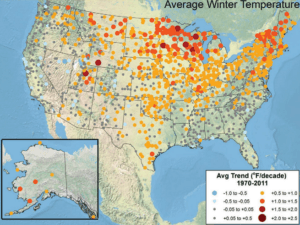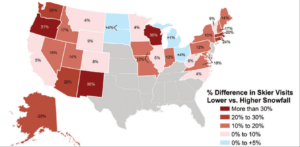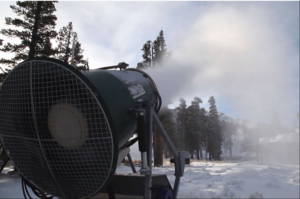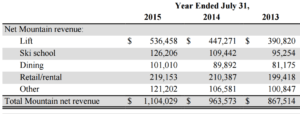EPIC Passes & Fake Snow: Vail Resorts Inc.’s Short Term Band-aid Solutions to Face Climate Change

Back home in Ecuador I am known as a “serrano” – a person who grow up in the altitude of the Andes. Although the largest mountain in the Ecuadorian Andes rises 3610 meters above sea level, I had never been able to enjoy what would be one of my favorite sports: skiing. This exciting sport only exists in the far northern and southern regions of planet Earth. Luckily, in 2014 I put on my first pair of ski boots and proceeded to jump down a steep downward mantle of white powder in Killington, Vermont. In 2016 I returned to the same ski region in New England. I asked the locals about last winter and their predictions for the upcoming one. Most of the responses to my question were “I just hope we get snow like we used to”
From New England, to the Alps and even Australia, the typical winter season scene could not be any more different. Years of increasing climate change continue to affect snowfall in regions which serve winter sports. In the case of the United States, global warming has created a major challenge for an industry which contributes $12.2B1 to the national economy. In particular, Vail Resorts Inc. (NYSE: MTN), the largest ski resort operator in the U.S., will have to come up with a serious response to address the concerns of shareholders – global warming is not an evil that can be solved by hiring a consulting firm.
U.S. Winter temperature trended up in the span of 1970-2011
Source: Natural Resources Defense Council (NRDC)
Vail Resort’s Inc. “Heavenly” resort in Lake Tahoe, California
Source: Fake Snow, Real Money: The High-Tech Fight to Save California Skiing, Bloomberg, Accessed November 2016
Vail Resorts Inc. operates 11 resorts in Colorado, California, Utah, Minnesota and Michigan. The company is divided in three integrated and cross-depending businesses: Mountain (snow sports), Lodging, and Real Estate. The overall “resort” experience is the combination of the Mountain and Lodging businesses, which represent 79% and 18% of overall company revenue respectively2. Revenue is driven by pricing and guest volume which is comprised of two categories: “in-state” and “destination” guests. The latter is especially important for Vail Resorts Inc. as this customer segment is extremely sensible to the quality of weather conditions (snow availability). Climate change has a direct consequence on the operations of Vail Resorts.
Average Difference in Skier Visits for Lower-Snowfall Years Compared to Higher-Snowfall Years Between November 1999-April 2010
Source: Natural Resources Defense Council (NRDC)
The amount and timing of snowfall during the winter season directly correlates to revenues and profits. On the revenue side, unusually warm winters can affect the amount of skiable terrain. As a consequence, customers are less motivated to travel out-of-state and thus expected lift tickets revenue and additional lodging / dinning revenue are not realized. On the costs side, snowmaking machines are required if natural snowfall is disappointing. As a result, operating costs could rise significantly. Snowmaking is driven by two factors: approval from a state’s Forest Service guided by the National Environmental Policy Act (NEPA)3, and water supply. Although Vail Resorts Inc. has controlling interests in multiple water reservoirs across the country, access to water still represents a future risk. In conclusion, the effect of global warming on the operation of ski resorts pressures both sides of the profit equation.
Snowmaking at Vail Resort’s Inc. “Heavenly” resort in Lake Tahoe, California
Source: Fake Snow, Real Money: The High-Tech Fight to Save California Skiing, Bloomberg, Accessed November 2016
To address the uncertainty of revenue coming from traveling guests, Vail Resorts Inc. has engaged in heavy marketing of customer-loyalty programs. The underlying rationale is that by selling “season passes” to in-state and out-of-state guests, these customers would commit to traveling to resorts regardless of weather conditions. Although this solution is not directly addressing the issue of climate change, it temporarily addresses revenue risks and customer attrition rates. Guests are sold on a “value” premise in which the season pass (“EPIC” Pass) price is equivalent to 4-5 daily passes. Guests have the ability to travel to multiple results under the same season pass for unlimited days. This strategy has proven successful as seen in Vail Resorts’ revenue growth.
Vail Resorts Inc. Revenues (in 000’s) ending July 31st
Sources: Vail Resorts Inc. Company Financials (10-K Filing 2015)
Moving forward, Vail Resorts Inc. should engage in long-term strategies which involve influencing policy that reduces the effects of global warming on mountain regions. Current company strategies are “ban-aid” solutions which could erode over time and put the interests of shareholders at risk in the long term. Furthermore, in the short term, Vail Resorts should immediately engage in water conservation efforts in order to guarantee the mineral’s availability for artificial snowmaking. The latter remains a ban-aid solution, yet it is a step in the right direction – a step towards adopting a culture conscious of climate change and its impact on business.
Sources:
1,3 “Climate Impacts on the Winter Tourism Economy in the United States”, Burakowski, Magnusson, University of New Hampshire, 2012
2 Vail Resorts Inc. Company Financials (10-K Filing 2015)








PHT, thanks for the interesting read. It does seem as though Vail is utilizing short-term strategies to combat the downturn in revenue due to snow availability. I wonder what more they will need to do for the long-term? For instance, is Vail lobbying groups to enact stricter regulations, thereby reducing global warming? I would imagine that Vail is such a tiny piece of the global puzzle that they don’t believe lobbying will do much good. It seems as though they could then turn to nearby organizations to band together to increase availability of water to make snow. For instance, when Vail or similar mountains do not have snow, I imagine all stakeholders are effected, including hotels, restaurants, ski schools, etc that are nearby. Perhaps they could put a local program in place in an effort to conserve water, something like hotels refusing to wash towels if they’ve only been used once by the same guest. In this way, all local stakeholders would benefit from the program. It would be a small change but could be useful in the effort to produce fake snow. That said, none of this would be helpful if the weather is too warm to even produce snow.